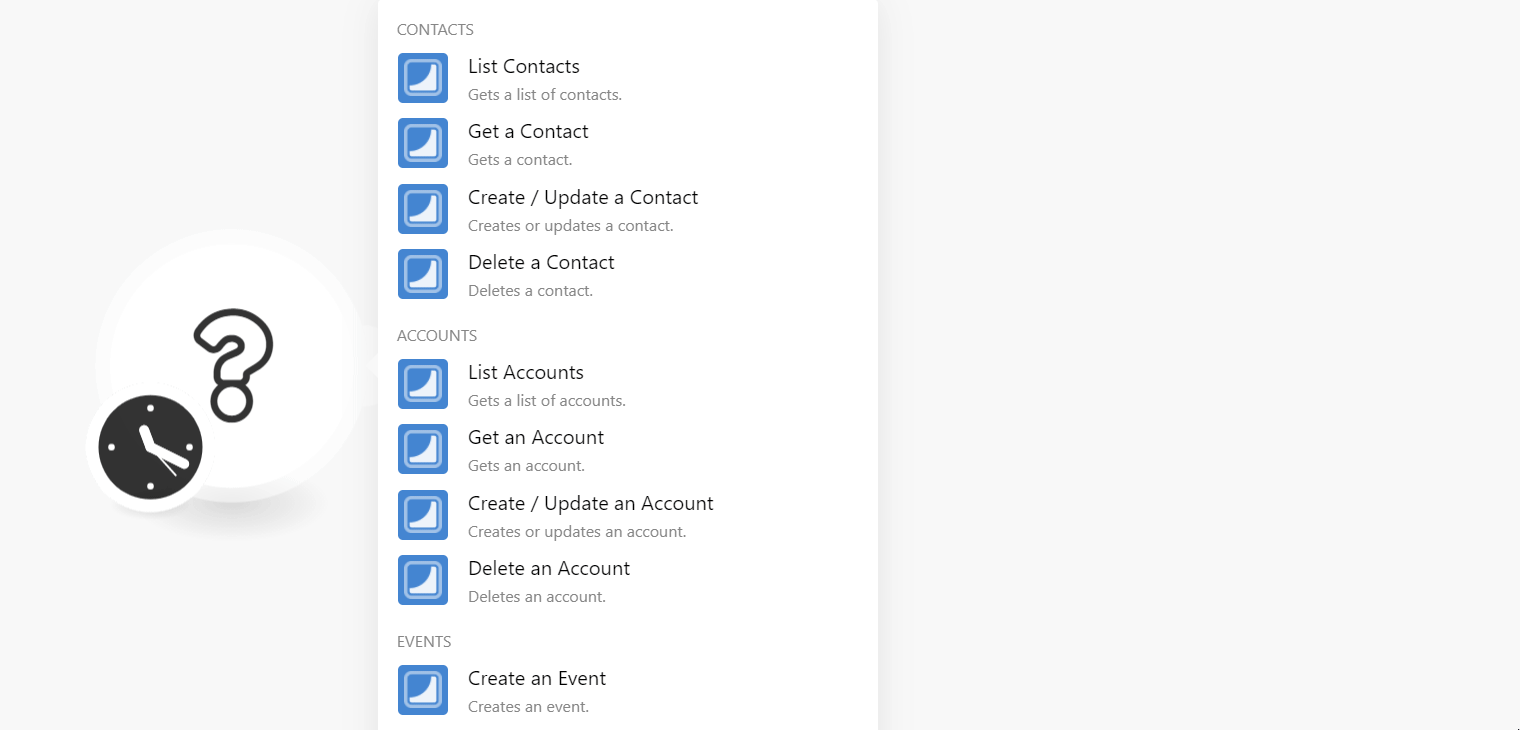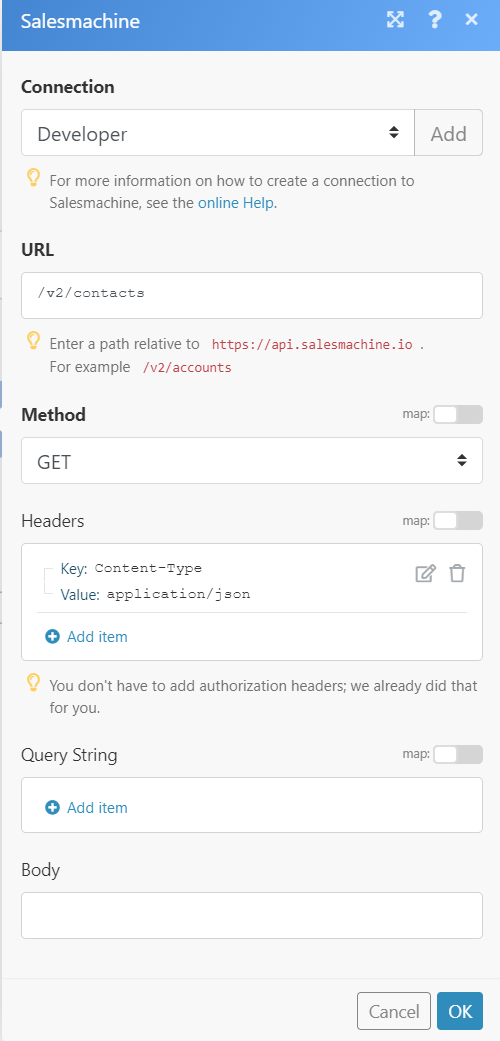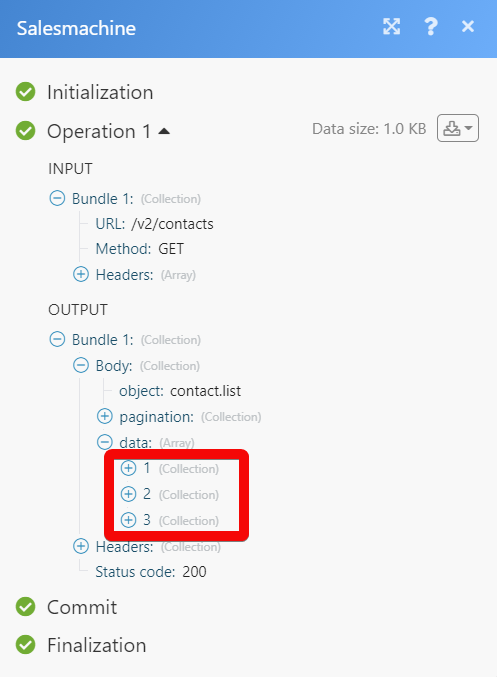| Active with remarks |
|---|
| This application needs additional settings. Please follow the documentation below to create your own connectionUnique, active service acces point to a network. There are different types of connections (API key, Oauth…). More. |
The Salesmachine modulesThe module is an application or tool within the Boost.space system. The entire system is built on this concept of modularity. (module - Contacts) More allow you to monitor, create, update, send, retrieve, and list the accounts, contacts, and events in your Salesmachine account.
A Salesmachine account – create an account at salesmachine.io
Connecting Salesmachine to Boost.spaceCentralization and synchronization platform, where you can organize and manage your data. More IntegratorPart of the Boost.space system, where you can create your connections and automate your processes. More
To connect your Salesmachine account to Boost.space Integrator you need to obtain the API TokenThe API token is a multi-digit code that allows a user to authenticate with cloud applications. More from your Salesmachine account and insert it in the Create a connection dialog in the Boost.space Integrator moduleThe module is an application or tool within the Boost.space system. The entire system is built on this concept of modularity. (module - Contacts) More.
1. Write to the [email protected] account.
2. Go to Boost.space Integrator and open the Salesmachine module’s Create a connection dialog.

3. In the Connection name field, enter a name for the connection.
4. In the API TokenThe API token is a multi-digit code that allows a user to authenticate with cloud applications. More v2 field, enter the token received from the sales team, and clickContinue.
![[Note]](https://docs.boost.space/wp-content/themes/bsdocs/docs-parser/HTML/css/image/note.png) |
Note |
|---|---|
|
Enter the v1 API token for the following modules:
|
The connection has been established.
You can create, update, list, retrieve, and delete the contacts using the following modules.
Gets a list of contacts.
|
Connection |
|
|
Limit |
Set the maximum number of contacts Boost.space Integrator should return during one execution cycleA cycle is the operation and commit/rollback phases of scenario execution. A scenario may have one or more cycles (one is the default).. |
|
Archived |
Select whether you want to list the archived contacts. |
|
Order |
Select or map the order in which you want to list the contacts. |
|
Sort |
Select or map the option to sort the contacts. |
Gets a contact.
|
Connection |
|
|
Contact ID |
Select or map the Contact ID whose details you want to retrieve. |
Creates or updates a contact.
![[Note]](https://docs.boost.space/wp-content/themes/bsdocs/docs-parser/HTML/css/image/note.png) |
Note |
|---|---|
|
Use the V1 API token to establish the connection for the proper execution of scenariosA specific connection between applications in which data can be transferred. Two types of scenarios: active/inactive. More. |
|
Connection |
|
|
Contact UID |
Select or map the Contact UID whose details you want to update. |
|
|
Enter (map) the contact’s email address. |
|
Name |
Enter (map) the contact’s name. |
|
Gender |
Enter (map) the contact’s gender. |
|
MRR |
Enter (map) the amount spent by the contact on the Salesmachine application. |
|
Account UID |
Enter (map) Account UID related to the contact. |
|
Churn Date |
Enter (map) the date on which the contact has canceled their subscription. |
|
Churn MMR |
Enter (map) the amount lost due to the cancelation. |
|
Churn Reason |
Enter (map) the reason for canceling the subscription. |
|
Churn Comment |
Enter (map) the comment text for churning the contact. |
Deletes a contact.
|
Connection |
|
|
Contact ID |
Select or map the Contact ID you want to delete. |
You can create, update, list, retrieve, and delete the accounts.
Gets a list of accounts.
|
Connection |
|
|
Limit |
Set the maximum number of accounts Boost.space Integrator should return during one execution cycle. |
|
Archived |
Select whether you want to list the archived accounts. |
|
Order |
Select or map the order in which you want to list the accounts. For example, |
|
Sort |
Select or map the option to sort the accounts. For example, |
Gets an account.
|
Connection |
|
|
Account ID |
Select or map the Account ID whose details you want to retrieve. |
Creates or updates an account.
![[Note]](https://docs.boost.space/wp-content/themes/bsdocs/docs-parser/HTML/css/image/note.png) |
Note |
|---|---|
|
Use V1 API token to establish the connection for proper execution of scenarios. |
|
Connection |
|
|
Account UID |
Select or map the Account UID whose details you want to create or update. If the specified Account UID is not present then a new account will be created. |
|
Name |
Enter (map) the account name. |
|
MRR |
Enter (map) the amount spent by the account. |
|
Domain |
Enter (map) the domain of the account. |
|
Chum Date |
Enter (map) the date on which the account was canceled. |
|
Churn MMR |
Enter (map) the amount canceled by the account. |
|
Churn Reason |
Enter (map) the reason for canceling the account. |
|
Churn Comment |
Enter (map) the comment text explaining the reason to churn the account. |
Deletes an account.
|
Connection |
|
|
Account ID |
Select or map the Account ID you want to delete. |
Creates an event.
![[Note]](https://docs.boost.space/wp-content/themes/bsdocs/docs-parser/HTML/css/image/note.png) |
Note |
|---|---|
|
UserCan use the system on a limited basis based on the rights assigned by the admin. More V1 API token to establish the connection for proper execution of the scenarios. |
|
Connection |
|
|
Contact UID |
Select or map the Contact UID whose event you want to create. |
|
Event UID |
Select or map the Event UID you want to create. |
|
Account UID |
Select or map the Account UID related to the event. |
|
Display Name |
Enter (map) the event name that displays in the account. |
You can make API calls using the following modules.
Performs an arbitrary authorized API call.
|
Connection |
||||
|
URL |
Enter a path relative to
|
|||
|
Method |
Select the HTTP method you want to use: GET to retrieve information for an entry. POST to create a new entry. PUT to update/replace an existing entry. PATCH to make a partial entry update. DELETE to delete an entry. |
|||
|
Headers |
Enter the desired request headers. You don’t have to add authorization headers; we already did that for you. |
|||
|
Query String |
Enter the request query string. |
|||
|
Body |
Enter the body content for your API call. |
The following API call returns all the contacts from your Salesmachine account:
URL: /v2/Contacts
Method: GET

Matches of the search can be found in the module’s Output under BundleA bundle is a chunk of data and the basic unit for use with modules. A bundle consists of items, similar to how a bag may contain separate, individual items. More > Body > data.
In our example, the 3 contacts were returned:

